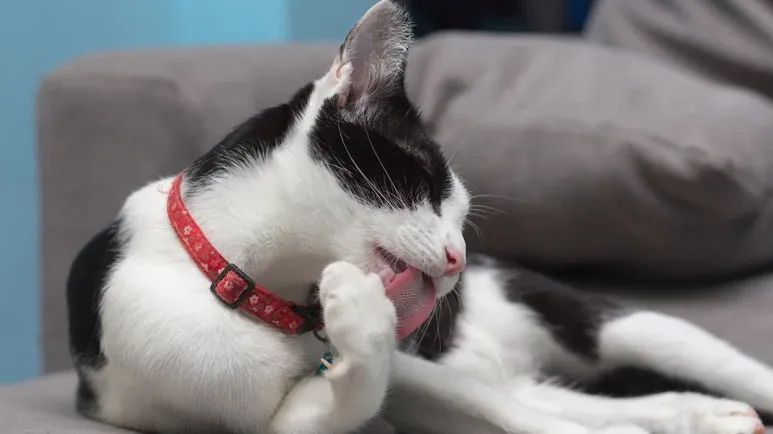Your Cat's Grooming Habits — What's Normal and What's Not?
A normal feline behavior, self-grooming consumes a large chunk of a cat's awake time. But when does it exceed the norm and turn into a compulsive disorder? Here's how to tell if your kitty is an overgroomer.

STORY AT-A-GLANCE
- Psychogenic alopecia or overgrooming in cats is a relatively common condition in which natural grooming behavior becomes compulsive
- Unlike normal grooming, overgrooming results in hair loss and skin damage
- The condition often begins as a displacement or coping behavior in cats experiencing chronic stress
- Since excessive grooming is seen in certain feline medical conditions and also have environmental causes, those must be ruled out before a diagnosis of psychogenic alopecia is made
- Treatment for compulsive grooming is focused on stress reduction and environmental enrichment; with patience and appropriate care, most cats with the condition will overcome it
Editor's Note: This article is a reprint. It was originally published October 27, 2020.
Self-grooming is normal feline behavior, so much so that cats spend a good chunk of their awake time licking, raking and pulling at their fur and skin to remove dirt and debris and keep their coats in good condition.
However, some cats eventually go overboard with their grooming, losing the ability to moderate their behavior and turning a natural hygiene practice into an abnormal compulsion. Kitties who excessively lick and groom themselves have a condition known as psychogenic alopecia, which is one of the most common feline compulsive disorders.
Normal or Compulsive? How to Tell the Difference
The average cat spends about 30% to 40% of the day grooming and much of the remaining time sleeping. That’s why it’s very common for pet parents to be unaware of an overgrooming situation until they notice significant hair loss, bald spots or scabs.
It’s also possible you won’t notice the behavior because when you’re at home with your cat, she feels more comfortable and relaxed and doesn’t need to act out her compulsion.
The obvious signs of psychogenic alopecia are excessive licking and chewing. More aggressive cats actually bite themselves and pull out clumps of hair. Other signs are areas of the coat that are chewed down to stubble, as well as skin wounds or ulcerations.
In cats who overgroom, hair loss and skin damage are localized to areas they reach with their mouth, such as the abdomen, flank, back, chest or inner legs. There may also be a line of stubble down the back or on the front of the legs that looks a bit like a “buzz cut.”
In addition to excessive licking, there are classic signs of stress such as hiding, refusing to eat, nervousness or not using the litterbox consistently.
Excessive Grooming Often Starts as a Displacement Behavior
Psychogenic alopecia in cats often begins as a displacement behavior in response to a change or stressor in the environment. Kitties do best with a daily routine that is predictable and reliable and provides them with a sense of control over their lives. When faced with consistent inconsistency, some cats begin repetitively performing a specific behavior such as grooming to help reduce the emotional tension they experience.
When a cat licks his fur and skin, calming endorphins are released. If the anxiety-producing situation is ongoing, the cat may perform the displacement behavior over and over until it becomes compulsive or habitual.
The type of stress that triggers excessive licking is typically persistent and is often a combination of cumulative stressors. For example, a new family member, a move to a new house or even relocating the litterbox upsets the average kitty and triggers displacement behaviors.
Psychogenic alopecia is seen more often in female cats. It occurs at any age but is commonly seen around the time of puberty. And there may be a genetic basis for the disorder since it’s seen primarily in certain purebred cats, especially oriental breeds that tend to have anxious temperaments.
The disorder also develops in kitties who are hospitalized, boarded, or otherwise deprived of their freedom (i.e., kenneled for an extended period of time). Bored cats often exhibit the behavior, as well as kitties who are frequently stressed or fearful.
Other Potential Causes
It’s important to differentiate psychogenic alopecia from other reasons cats lick specific areas of their bodies, such as pain or some type of skin condition. There are actually many underlying medical reasons that cause cats to overgroom.
If the problem is generalized itching, the licking will be widespread. If there’s a painful area, the licking will be focused on that spot. Where a cat focuses her licking gives clues as to the underlying issue, which is any number of things, including:
- Food or specific ingredient intolerances
- A reaction to dust, pollen or mold
- The presence of environmental toxins (e.g., flame retardants, VOCs, phthalates, scented candles or room sprays or plug-ins, household cleaning chemicals)
- Fleas or other parasites
- Neurologic or chiropractic issues
Conditions that aren’t skin-related but cause excessive grooming include cystitis (inflammation of the bladder), hyperthyroidism and anal sac problems.
Identifying and correcting underlying environmental and medical issues is important before assuming your cat is licking for an emotional reason. If a kitty licks to the point of breaking the skin, infection will occur. The presence of infection will intensify the licking, which results in an even more serious infection and a vicious cycle develops.
How to Handle Psychogenic Alopecia
When medical issues have been either ruled out or resolved and you’ve narrowed the problem down to an issue of compulsive behavioral licking, treatment should be focused on stress reduction and environmental enrichment.
Again, consistency is key. Cats like to eat at the same time every day, so make feeding time very reliable. Keep food bowls and litterboxes in the same location and, of course, very clean. Consider investing in an indoor hunting feeder filled with freeze-dried morsels you can hide around your house for your cat to discover and help her express natural feline behaviors, like stalking prey.
Provide her with plenty of hiding boxes, access to high perches and appropriate scratching surfaces. Reduce LED and fluorescent lighting, loud noises and EMFs in a part of your home your cat can retreat to for peace and quiet, whenever necessary.
Most cats enjoy interacting with their humans, so take time every day to be present with your kitty to ensure her emotional and social needs are being met.
Also, be sure to get your cat moving every day with interactive toys like a laser pointer or wand toy. Many cats today are bored to the point that it’s unhealthy, so it’s important to provide yours with options for mental stimulation throughout the day.
Catios (cat patios) and safe time spent outside are also wonderful for indoor cats because these allow them to experience the natural world. Open the curtains or blinds before you leave for work so she can see outside. Consider installing window perches and playing kitty videos while you’re away.
Brushing your cat’s coat is beneficial for removing loose hair and cutting down on hairballs, and many kitties really enjoy the attention.
Talk to an integrative veterinarian about titers, in place of unnecessary vaccines and add in natural stress remedies for anxious cats. Consider using flower essences, homeopathy and acupuncture with stressed kitties, as well as feline facial pheromone sprays such as Feliway. CBD oil is also very beneficial for stressed cats, as are catnip, silver vine and valerian root.
Most importantly, you need to be patient, and please don’t ever punish your cat for overgrooming, as it will only make the situation much worse. Excessive grooming problems take time to resolve, much like any other compulsive behavior.
With consistent attention, affection, environmental enrichment and a dependable daily routine, most kitties are able to conquer psychogenic alopecia, if addressed early enough. They regrow their hair and their quality of life improves within a few months’ time.











